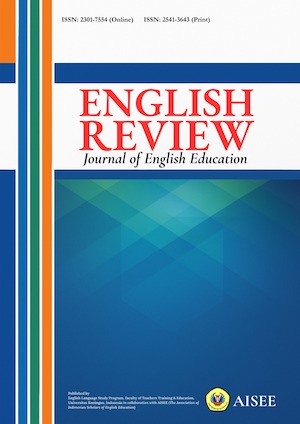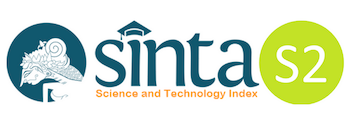The correlations among critical thinking skills, critical reading skills and reading comprehension
Abstract
Critical thinking skills, critical reading skills and reading comprehension were the most crucial life skills that should be mastered by the students, especially for university students. The objectives of this study were: (1) to find out whether or not there was a significant correlation among students critical thinking skills and reading comprehension, (2) to find out whether or not there was a significant correlation among critical reading skills and reading comprehension, and (3) to find out whether or not there was a significant correlation among the predictor variables (critical thinking skills and critical reading skills) and the criterion variable (reading comprehension) of English Education Study Program students of UIN Raden Fatah Palembang. In this study, 90 undergraduate English Education Study Program of UIN Raden Fatah Palembang in the academic year 2018/2019 in the fourth semester were chosen as a sample by means of purposive sampling. This study conducted correlational research design. The data were collected by using tests. Pearson Product Moment correlation and regression were used to analyzed the data. Based on the data collected and analyses applied in this study, the findings revealed that (1) there was a significant correlation among critical thinking skills and reading comprehension with r-value 0.810, (2) there was a significant correlation among critical reading skills and reading comprehension with r-value 0.844, (3) there was a significant correlation among predictor variables (critical thinking skills and critical reading skills) gave 71.3% contribution to criterion variable (reading comprehension).References
Akyuz, H. I., & Samsa, S. (2009). The effects of blended learning environment on the critical thinking skills of students. Journal of Procedia Social and Behavioral Sciences, 1, 1744-1748.
Baier, R. J. (2005). Reading comprehension and reading strategies (A research paper submitted in partial fulfillment of the requirements for the master of education degree in education, University of Wisconsin-Stout, AS). Retrieved from https://minds.wisconsin.edu/handle1793/41543
Bezanilla, M.J., Nogueira, D.F., Poblete, M., & Dominguez, H.G. (2019). Methodologies for teaching-learning critical thinking in higher education: The teacher’s view. Thinking Skills and Creativity, 33.
Broek, P. V. D., Kremer, K. E. (2000). The mind in action: What it means to comprehend during reading. In B. M. Taylor & P. V. D. Broek (Eds.), Reading for meaning: Fostering comprehension in the middle grades, Newark, DE, 1-31.
Cleveland State University. (2017). Critical reading. Retrieved from https://www.csuohio.edu/writing-center/critical-reading-what-critical-reading-and-why-do-i-need-do-it.
Collegiate assessment of academic proficiency (CAAP) critical thinking sample test questions booklet. (2008). American College Testing Program: ACT. http://www.act.org/
Commeyras, M. (1990). Analyzing a critical-thinking reading lesson. Journal of Teaching and Teacher Education. 6(3), 201-214.
Dianti, R. (2013). The correlation between critical thinking skills and critical reading skills of English education study program students of Sriwijaya University (Magister’s thesis, Sriwijaya University, Palembang, Indonesia).
Ennis, R. H. (2011, January 10). What is critical thinking. Retrieved from http://www.criticalthinking.net/definition.html
Ghanizadeh, A., Hoorie, A.H., & Jahedizadeh, S. (2020). Higher order thinking skills in the language classroom: A concise guide. Second Language Learning and Teaching. Berlin: Springer link.
Hammond, L.D., Flook, L., Harvey, C.C., Barron, B., & Osher, D. (2020). Implication for educational practice of the science of learning and development. Applied Development Science, 24(2), 97-140
Hansen, E. J. (2016). Reading comprehension (Master i fremmedspråk i skolen, fordypning i engelsk). Retrieved from https://brage.bibsys.no/xmlui/bitstream/handle/11250/2396307/16-00400-21
Heinemann, M. (1996). The Heinemann ELT TOEFL preparation course. Oxford: Macmillan Education.
Hudson, T. (2007). Teaching second language reading. Oxford: Oxford University Press.
Kurland, D. J. (2000). How the language really works: The fundamentals of critical reading and effective writing. Retrieved from http://www.criticalreading.com/critical reading thinking.htm
Peterson’s, T. (2005). Peterson’s new SAT critical reading workbook. United States of America: A Nelnet Company. Retrieved from https://www.petersons.com
Pirozzi, R. P. (2003). Critical thinking & critical reading. New York, NY: Longman.
Pnevmatikos, D., Christodoulou, P., & Georgiadou, T. (2019). Promoting critical thinking in higher education through the values and knowledge education (VaKE) method. Studies in Higher Education. 44(5).
Saleh, S.E. (2019). Critical thinking as a 21st century skill: Conceptions, implementation, and challenges in the EFL classroom. European Journal of Foreign Language Teaching, 4(1), 1-16.
Shanahan, T. (2006). The national reading panel report: Practical advice for teachers. University of Illinois, Chicago.
Trinidad, J.E., Ngo, G.R., Nevada, A.M., & Morales, J.A. (2020). Engaging and/or Effective? Students’ Evaluation of Pedagogical Practices in Higher Education. College Teaching Journal, 68(4), 161-171.
UNESCO. (2011). World data on education. (7thed.). Retrieved from http://www.ibe.unesco.or.id
Woolley, G. (2011). Reading comprehension: Assisting children with learning difficulties. Springer Science + Business Media. DOI 10.1007/978-94-007-1174-7 2.
Zabit, M. N. (2010). Problem-based learning on students’ critical thinking skills in teaching business education in Malaysia: A literature review. American Journal of Business Education, 3(6), 19-32.
Zin, Z. M., Eng, W. B., & Galea, S. R. (2014). Critical reading ability and its relation to L2 proficiency of Malaysian ESL learners. 3L: The Southeast Asian Journal of English Language Studies, 20(2), 43-54. http://dx.doi.org/10.17576/3L-2014-2002-0
All articles published in English Review: Journal of English Education (ERJEE) are licensed under the Creative Commons Attribution 4.0 International License (CC BY 4.0).
Copyright Ownership
Authors retain the copyright of their articles and grant ERJEE the right of first publication. The journal is granted a non-exclusive license to publish, reproduce, and distribute the article in any format, medium, or platform, provided that proper credit is given to the original authors.
License Terms – CC BY 4.0
Under the Creative Commons Attribution 4.0 International License, others are free to:
- Share — copy and redistribute the material in any medium or format
- Adapt — remix, transform, and build upon the material for any purpose, even commercially
As long as they:
- Provide appropriate credit to the original author(s) and source
- Provide a link to the license (https://creativecommons.org/licenses/by/4.0/)
- Indicate if any changes were made
There are no restrictions on the reuse, reproduction, or adaptation of published articles as long as attribution is properly given.
Author Warranties
By submitting a manuscript to ERJEE, authors confirm that:
- The work is original and does not infringe any existing copyright.
- The manuscript has not been previously published and is not under consideration elsewhere.
- All sources and references are appropriately acknowledged.
- Necessary permissions have been obtained for any copyrighted materials used.









